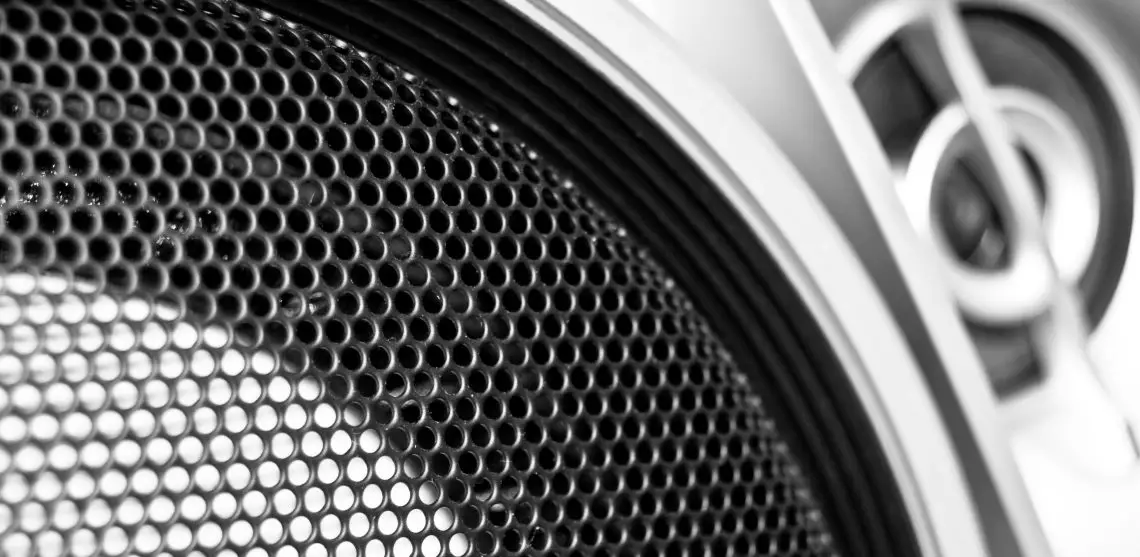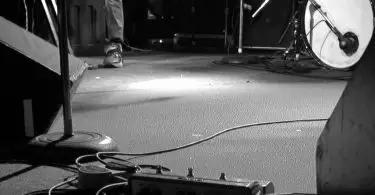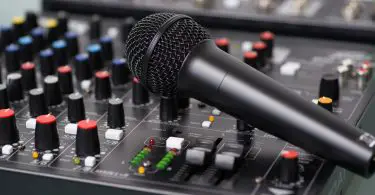I set out to find the best PA speaker on the market right now, but before we get there, I want to explain my reasoning and tell you what you should look for in a PA speaker if you are ready to buy.
Why You Should Trust Us
Although I’m not active now, I spent years as a musician gigging in various venues. Between myself and my friends I’ve seen a lot of audio setups, so I know what it takes to get something that works for a good price.
I spent a long time trying to come up with a good list of PA speakers; then I narrowed it down to the best of the best with testing and interviews with users. I wanted to nail down what features are most important and what prices are reasonable for speakers of different types.

Credit: Amazon.com
Top Pick: Behringer EUROLIVE B315D
While it isn’t the most powerful speaker you can buy, it gives you a lot of sound for your dollar with a useful feature set, excellent sound quality, and durability. Weighs surprisingly little considering its size and output.
Key Features and Attributes
In this section, I’ll run down what I found to be the most important characteristics. Even if you don’t agree with my picks for the best PA speakers, you should be able to use this section as a guide to figure out what you need and how much you should pay for it.
It will be an ongoing theme that what is most important in a speaker will be very different if you are buying it to install in one venue as opposed to buying it as a musician looking to tour or travel, so keep that in mind as we discuss the key features a PA speaker can have.
Powered and Unpowered
PA speakers, like other speakers, are divided into two main styles: powered and unpowered. Powered speakers have their own amp integrated into the system, while unpowered ones will need an amp to produce sound. Why do you need an amplifier?
Because the raw signal from your instruments and vocals is too weak to play into a venue. The amp strengthens the power of that signal so that the speaker can play it at a volume high enough to be audible.
Deciding on whether to go with a powered or unpowered speaker depends on the role the speaker will play. For musicians, especially touring ones, powered PA speakers are better because they are more convenient and compact. They are easier to work with when you are traveling around or playing on irregular schedules.
On the other hand, a venue manager might prefer to buy unpowered speakers. If you want to install them permanently in a concert hall, church, or another venue, then the advantage of unpowered speakers is that if the amp or the speaker breaks, you can swap it out and replace it without having to replace both elements. That is cheaper and easier than having to re-buy an entire integrated unit.
Size and Wattage
There are two main attributes that determine how loud a speaker can play and how well its sound covers the venue. The first is the power it can use, which is measured in watts.
A speaker that can use a lot of power can fill a much bigger venue. A big speaker might be 1000 watts or more, and a smaller one might only be 100 watts.
There are two measurements of a speaker’s power: typical use and peak. Typical use is how much the speaker can handle for prolonged periods without damage. Peak is how much it can handle for a short burst.
You should look at typical use for an idea of how much reliable power you have. If you have an unpowered speaker, it’s a waste to buy an amp that pushes more power than the speaker can use.
The other attribute is the size of the speaker cones. The range is from 8 inches to about 12, with bigger sizes generally coming only on subwoofers. The speaker cone and its positioning not only partially determine how loud the speaker gets, but also how wide of an angle the sound reaches.
A well-positioned and broad cone can push sound out in a wide arc, and smaller cones have narrower angles. Some speaker designs use intentionally smaller angles to get a more intense experience in a narrower area.
Before you invest in a speaker, investigate its coverage and match that to where the speaker will be used.
Durability and Portability
PA speakers cost a good amount of money, like a lot of other audio equipment, so it’s very important that they last a long time. You want it to give you years of full functionality.
That can potentially include time on the road, where it might be bumped around or banged. A top shelf speaker that can’t last longer than ten months is much less valuable than a slightly less dazzling one that will work the same way for five years.
It can be hard to predict how durable a speaker will be, especially a new one that hasn’t been on the market very long, so use what you know about each brand’s reputation and history to help guide your decision.
Portability also matters. A lighter, smaller speaker with handles or other features is a lot easier to carry around than a bulky one.
Although tougher speakers are usually heavier, it is possible to find good and reliable speakers at reasonable weights. Size and weight make it harder to get a speaker around, so don’t underestimate the power of convenience.
Crossover and Sound Quality
The crossover of a speaker is an important part of how you hear its sound.Generally PA speakers have two actual speakers inside: a smaller one for high-frequency sound and a bigger one for the low end.
Each speaker has an internal mechanism that determines which part of each sound signal gets fed to each speaker cone. As you go up the frequency spectrum, playing higher and higher notes, you reach a point where the speaker “crosses over” from using the big low cone to the small high one.
If the audience can hear this point, that’s a bad sign, because it can sound strange and artificial. Ideally, with good speaker design, the two will meld into each other and you won’t be able to detect the crossover.
Every speaker with more than one speaker cone has a crossover point. It just comes down to whether you can hear the handoff from one to the next.
That’s just one part of overall sound quality.
Another is the frequency response, or how many different frequencies a speaker can produce. Others include things like whether the speaker adds bad distortion to the sound signal, whether it has digital signal processing to clean up and mix the signal, whether and what kind of EQ it has, and so on.
Value
Lastly, you need to get good value for your money. There are a lot of really good speakers that simply cost too much.
You don’t want to overpay for speakers because they can get extremely costly and you will usually need a set of them, not just one. So it pays to know which models are worth the money and which are overpriced.
Everyone in this industry knows how tempting it is to overspend, so it’s critical to pick a budget and settle on it, finding good value buys without breaking the bank.
You will see models that are a little outside your budget that attract your attention, but a big part of getting good value is staying within your budget at all costs.
| Instrument | Rating | Current Pricing |
|---|---|---|
Behringer EUROLIVE B315D | great value for the quality, weighs surprisingly little considering its size and output |  |
Yamaha DXR15 Powered Speaker Cabinet | It includes an extensive onboard mixer to help you control your tone |  |
QSC K10 | Two-way speaker that can be a monitor or a main |  |
Top Pick: Behringer EUROLIVE B315D

Credit: Amazon.com
I believe that the best PA speaker you can get is the Behringer EUROLIVE B315D. It is a 400-watt speaker that will run you about $600. It has a huge 15-inch low-frequency driver for the bass tones and a 1.75-inch driver for high frequencies.
It is an active speaker that weighs surprisingly little considering its size and output. The B315D is a excellent value, and while it isn’t the most powerful speaker you can buy, it gives you a lot of sound for your dollar combined with several convenient features.
Behringer is known for the quality of their construction. Their big innovation in the D series of speakers is a new power system that rapidly switches on and off when needed, which allows the designers to avoid having to install a heat sink.
That makes the speaker much lighter than it would otherwise be, and it is a little under 60 pounds. Considering what is in it, that is very good.
The frame is tough and durable, and there’s no question that you can take the B315D on tour.
Another neat feature is the onboard sound processing. This isn’t quite a full mixer, but the speaker will automatically lowers the bass signal at the highest volumes, which permits maximum volume output without distortion or other problems.
You get a two-band EQ with HIGH and LOW segments along with an ultra low-noise mic input that has its own level control.
The B315D is built to be used as either a main or a monitor, and you can lay it down on its side in wedge form if you choose to use it as a monitor. That is great flexibility because depending on the venue you are playing, your other gear, and what you want to do with the speaker, there might be times when you want it as a main and other when you want it as a monitor.
In fact, its low distortion and good construction mean you could even use it as a studio monitor. With the right adapter, you could connect an mp3, CD, or cassette tape player to the speakers for a 90s party. A big part of the value of this speaker is just how much you can do with it.
The bottom line is that you can find louder speakers, bigger speakers, and fancier speakers, but you won’t find any that give you better value. Whether you tour or play one venue, and whether you want a full main or a monitor, it’s hard to do better with your money than the B315D.
Runner Up: Yamaha DXR15 Powered Speaker Cabinet

Credit: Yamaha Corporation
If you want to spend a little more money and get an upgrade, the Yamaha DXR15 Powered Speaker Cabinet is a nice choice. It is rated for 1100 watts, so it can push more power through the circuits, and the big transducer is the same size as on the Behringer. The price is $800.
In addition to the greater power, the Yamaha has a more distinguished feature set. There is an onboard digital signal processor that automatically optimizes the EQ of your sound no matter what frequencies or volume you are using.
The same processor also protects the amp, power supply, and other components from blowouts and other electrical problems, significantly improving the reliability and lifetime of the speaker.
Just like the Behringer, the Yamaha is a class D amp, but it does weigh a little more at just over 60 pounds. It can be used in main or wedge monitor mode or be mounted on a pole. It includes an extensive onboard mixer to help you control your tone.
The biggest downside to the Yamaha is that you need to pay an extra 33 percent more over the Behringer. If the feature set is worth it, then your choice is clear.
Honorable Mention:
QSC K10

Credit: QSC, LLC
The QSC K10 2-Way Powered Speaker is another two-way speaker that can be a monitor or a main. It costs $750 and runs 1000 watts with a 10-inch large transducer. The QSC is similar to the first two options on my list, but I have to take off some points because it doesn’t offer as good a value.
There is an onboard DSP and a limited EQ, and you can mount it up on a pole if you wish. Perhaps the distinguishing feature of the QSC is its weight. At just 33 pounds, it is really easy to carry around.
The QSC is similar to the Behringer in its ability to have a complete sound that is free of obvious crossover points. It’s also a class D design, so that tells you how come it can be so light and yet deliver this level of power.
The K10 has a lot of fans, but it is a bit of an older model, having come out back in 2009, so newer speakers tend to have better tools and design. That said, if you like the way it sounds and you can get it at a good price, don’t hesitate to buy the K10 because it can fill the same role as the first two speakers.
The Peavey PV 115 2-Way 15″ 800W Active Pro DJ Live Sound Speaker System is a bit of a budget option. It costs $500, but you actually get two speakers in the pack for that price, so they are $250 each. That is a really good deal.
They have the usual main and monitor setup and as the name implies, each one has a 15-inch transducer and 400 watts of power. They are unpowered, so you will need an amp to use them.
They do not have any of the fancy features of the higher end speakers, so don’t expect to see a mixer, a DSP, or an EQ here.
If you already have an amp or you are a venue operator, then an unpowered speaker can be a real savings and easier to replace if damaged. Considering the price of the PVs, these are affordable for just about anyone.
You can use them as a low-end monitor, and they are powerful enough for that role, and they do well in medium to small venues as well. Note that in quieter venues, such as a church, they will be able to fill more space.








Start the discussion at talk.hearthemusicplay.com